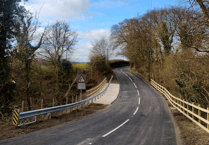FORELAND Point is the most northerly section of Exmoor, a triangular promontory consisting of Hangman Sandstone, and situated between Porlock and Lynmouth. The triangle is about a mile long from its northerly tip to the base with the base line about a mile and a half. Its highest point is 220 metres (723 ft) above sea level.
When I used to be able to enjoy this walk, we would park at Barna Barrow car park and follow the track down to Exmoor’s only lighthouse. The way passes east at first through farmland before coming to Kipscombe Enclosure.
Then it turns west into Coddow Combe, keeping to the track to the lighthouse. In 1249 Kipscombe was written as ‘Kyppescumb’ i.e. Cyppi’s valley. The derivation of Coddow is not known, but ‘cod’ is often a euphemism for ‘god’ in place names, as in Codsend, so this combe might be ‘God’s own valley’.
The lighthouse was built in 1900 by Trinity House. The tower is 15 metres high and the light is described on old OS maps as ‘revolving white.’ It was electrified in 1975 and was operated by a resident keeper until automated in 1994. It has a range of 18 nautical miles. The former ‘Keeper’s Cottage’ behind the lighthouse is now let out as a holiday home.
Peering over the railings at the sea crashing on the sheer rocky cliffs many hundreds of feet below, it is immediately apparent why it is necessary to have a light in this situation. There is no beach at the foot of the cliffs here and the waves and wind on a dark and stormy night must be terrifying.
It is a different picture on a warm sunny day with a calm sea. The cliff-faces here are an attraction to rock climbers. Some of their climbs are well described by the late Kester Webb in his book The Hidden Edge of Exmoor. On a clear day there are breath-taking views across the Bristol Channel to Wales as well as east and west along the Exmoor coastline.
This area also attracts bird lovers, who are rarely disappointed. Find a position overlooking the sea and cliffs and, at the appropriate time of year, there is a good chance of seeing Razorbill, Guillemot, Kittiwake, Fulmar, Manx Shearwater, Cormorant and Shag, as well as an assortment of gulls, many from nearby breeding colonies.
In the past there was great excitement when a red-billed Chough, probably from Wales, flew by. Plant enthusiasts will enjoy the pink Sea Thrift, which used to be illustrated on the twelve-sided threepenny bits in the former sterling coinage. Sea Campion forms white patches alongside blue Sheep’s-bit Scabious and the scented wild thyme.
When you have had your fill of these delights, it is best to go back up the lighthouse track, passing the stream which flows down Coddow Combe, and then turn west after about a quarter of a mile to join the South West Coast Path across the centre of The Foreland.
Here the habitat changes to Coastal Heath, that delightful mix of close-packed heathers, low-growing Western Gorse and flaxen grasses. Exmoor holds an important percentage of this scarce habitat.
These plants attract bees, butterflies, moths and other invertebrates. Being a coastal environment, this is a good place to spot migrant butterflies such as Clouded Yellow and Painted Lady. Small Coppers and Small Heath are often seen.
Adders and Common Lizards bask in sunny areas and Red Deer visit the area. Rabbits and small rodents are sometimes seen and birds to look for include Redpoll, Wheatear, Meadow Pipit and
Stonechat. Listen out for the overhead calls of Raven, Buzzard, Peregrine or Kite and in winter you may see Snow Bunting.
The land here was purchased by the National Trust in December 1971. Follow the path towards the gully known as Great Red on the west side of The Foreland. This is another good area for plants such as Sea Campion and Thrift.
Then strike south across Butter Hill. It is well worth continuing a short way along the track to Countisbury Church as it has an interesting history and connections with the Rev. Thornton, who later became the first vicar of the newly-created Parish of Exmoor in 1856.
Retrace your steps a few yards to leave the coast path and follow the track back to Barna Barrow car park, where you began one of the finest walks on Exmoor - providing you were blessed with the weather.
For more information about the work of the Exmoor Natural History Society visit www.enhs.org.uk.




